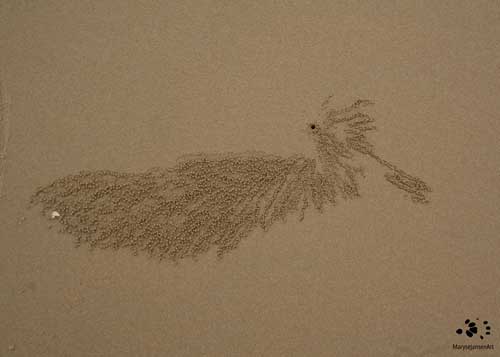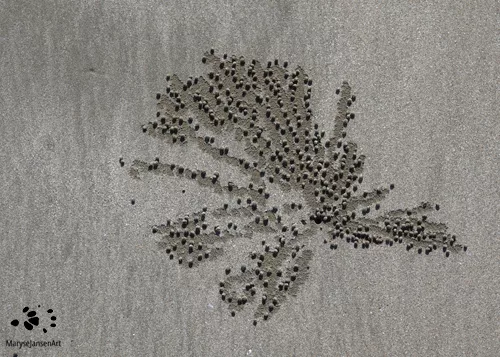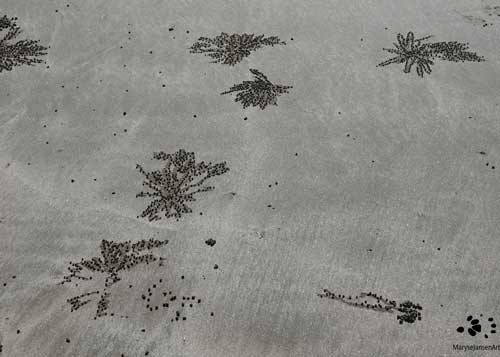Nature Photography with marysejansenart
Tiny little crabs produce natural art galleries on the beach

When I first visit the Australian east coast, I discover an interesting phenomenon on some of the beaches. They are littered with little sand balls, randomly scattered around in strange, sometimes beautiful patterns. As I begin to study them up close I notice that somewhere in the centre of each of those shapes is a little hole in the sand. After a while I can see that tiny crabs move in and out of these holes: they are called Sand Bubbler Crabs!
Table of Contents
Sand Bubbler Crabs – Scopimera inflata
Sand Bubbler Crabs are a common sight in the Indo-Pacific area. Currently, 23 species have been recognised. The crabs I see here, on the subtropical and tropical beaches of eastern Australia are Scopimera inflata, a species endemic to Australia. They are very small, they can grow up to just over a centimetre across, excluding the legs. It’s not just their small size, but their colouring also makes it tricky to spot them. The sandy brown colouration has them well camouflaged on the sand! And when they have the least sense of a threat they are quick to disappear in the little holes which are their burrows.
I enjoy watching them scurrying around for a while, but I am even more fascinated by the patterns of the little sand balls! Check out the featured image, what does it look like to you?
Crabs create art on the beach as a byproduct of their feeding behaviour
So, where do all these little balls come from? They are made by those little crabs! The Sand Bubbler Crabs feed by filtering sand through their mouth parts, eating the micro-organisms and detritus that they find in there. They discard the sand in the form of little balls, probably to prevent sieving through the same sand twice, and kick it aside. They tend to start foraging close to their burrow and spiral out as they cover their territory. Moving around in this spiralling way causes them to create these beautiful patterns on the beach! Isn’t that amazing!?
They actively defend their territory against other Sand Bubbler Crabs. They may be seen practicing threat displays and will also fight. Their burrows are important hiding places when predators are nearby, such as Red-capped Plovers. This is why they stay as close to their burrows as possible when feeding and spiral around it rather then venturing out in a straight line.
Their feeding time is limited to low tide. The more sand balls you see, the longer the tide has been out. When there are lots of crabs, the density of the patterns increases and the individual shapes melt together into one big masterpiece!

The tidal cycle
All of it gets swiped away by the water when the tide comes back in and the little crabs disappear in their burrows. They wait out high tide in there in an air bubble. This is why they are called Bubbler Crabs! Bubbler Crabs have an interesting way of breathing. They have membranes on their legs where aerial gas exchange takes place which basically means they breathe through the ‘windows in their legs’. The scientific name of their genus ‘Scopimera’ means ‘thighs with windows in them’!
To have the most opportunity to feed during the tidal cycle they tend to aggregate just below the high tide mark. Interestingly females choose to be mainly on the seaward side and males on the landward side of their aggregation. It has also been observed that the larger crabs tend to occur on the landward side. That seems to make sense as the bigger, stronger crabs will claim the spots with more opportunity to feed.
After the water recedes it takes at least one to two hours before the crabs begin to emerge again. They first clear their burrows of waste sand and then begin to repeat the feeding process and the creation of new crab art!
Natural Art Galleries
Every now and then, when I travel to more northern areas of Queensland, I am able to enjoy these fascinating temporary natural art galleries. They are full of natural abstracts and some of the pieces really seem to resemble something we know, like the featured image which to me looks a bit like a bird. Or like the scene below, which reminds me of a display of fireworks! I’ll leave it up to you what you see in the other piece. Let me know in the comments, I’d love to hear from you!

Read more posts about crabs here!
Join me on my walk exploring the beaches and rocky shores of the Capricorn Coast and spot the Sand Bubbler Crab in the latest episode of ‘Come for a walk in the Australian Bush’!
If you are interested in purchasing a print of the featured image ‘Sand Art Series – Crab Art’ or would like to see what the image looks like on the various merchandise products, please head to my shop. For more Crab Art and other interesting natural abstracts, visit my Abstracts In Nature Gallery.


